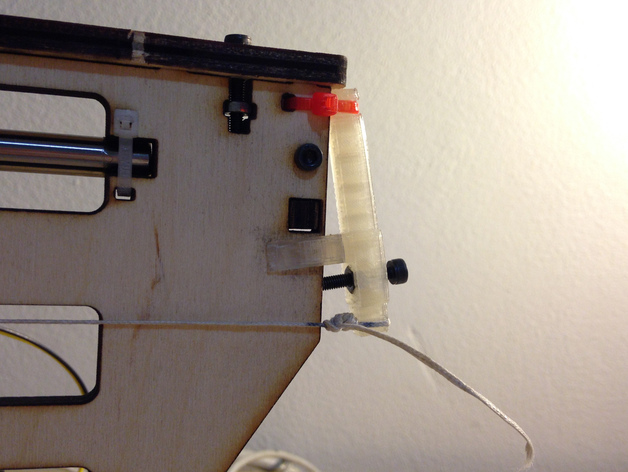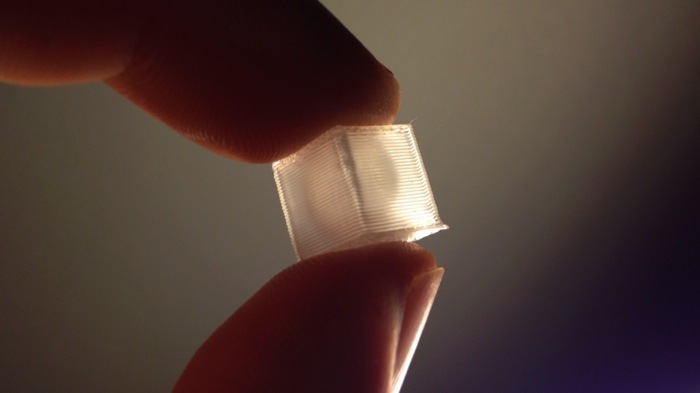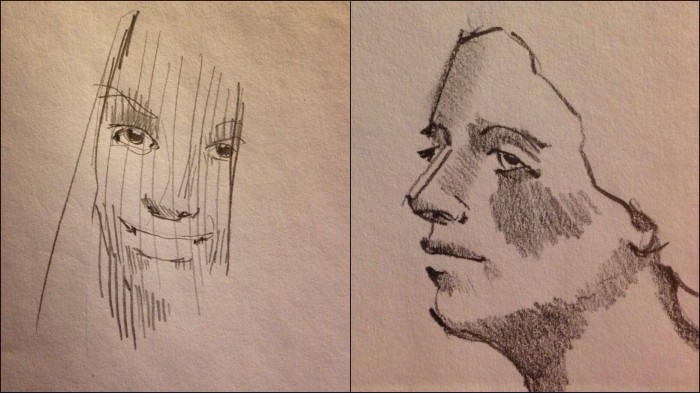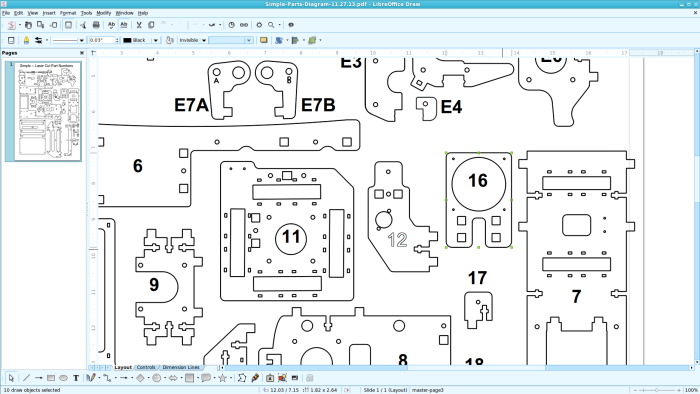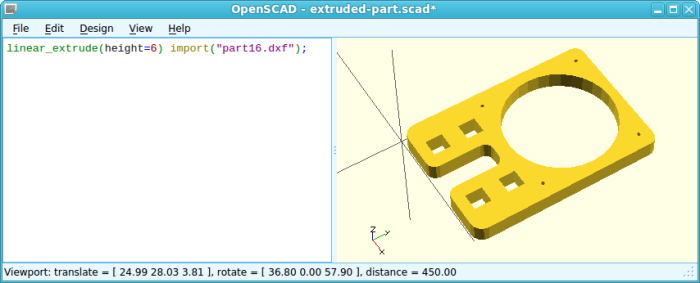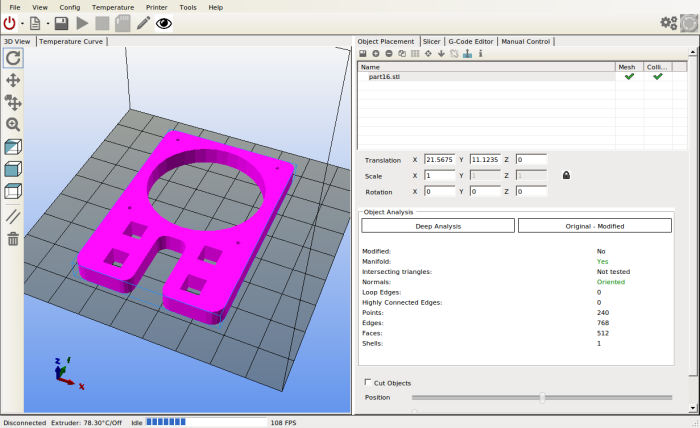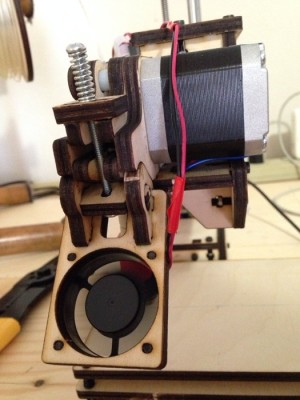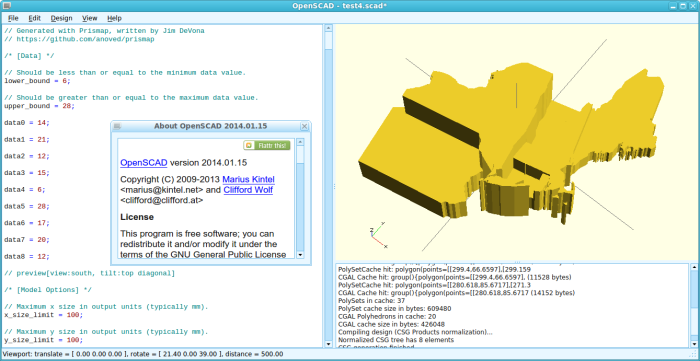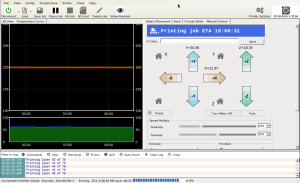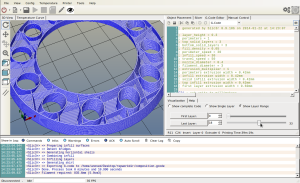Category Archive: “Uncategorized”
Printrbot Tensioner
As a followup to my post about making printable models from PDF part diagrams, here is a replacement Printrbot tensioner I made using that method. (The original did not need to be replaced; I just chose this part as a simple test case. It’s working great.)
The original tensioner is assembled from two laser-cut wood parts, numbered 21 and 22 in the Printrbot Simple’s diagram. I exported the patterns per the process described in the post linked above and combined them using the following OpenSCAD script. Note that part 22 has a partly recessed socket for a hex nut, which I exported separately.
module part_22() {
difference() {
// Part 22, with bolt holes
linear_extrude(height=6) import("part-22.dxf");
// Subtract the hex nut socket from part 22
translate([398.15 - 394.29, 525.66 - 489.21, 3])
linear_extrude(height=3) import("part-22-hex.dxf");
}
}
module part_21() {
// Part 21, not including hole through which 22 goes
linear_extrude(height=6) import("part-21-solid.dxf");
}
union() {
part_22();
translate([0, 36, 458.88 - 462.4]) rotate([90, 0, 0]) part_21();
}
The parts are aligned using positions reported for each feature in LibreOffice. The actual position on the page doesn’t matter; only the difference between them is used to get things centered.
The STL exported from this script could be used to make an exact replacement for the original assembly. Instead, I imported it into SketchUp using the SketchUp STL plugin and made a few changes to simplify the part and make it easier to print without supports. This is the final version published on Thingiverse.
Posted on Tuesday, February 11th, 2014.
Making Faces Videos
I’ve been recording some time lapse videos of sketch sessions. Recorded at 5 seconds per frame; played at 5 frames per second. (25×?)
That last one is not of portrait drawing, of course, but of painting a 3D-printed landscape model.
I’m using the lamp clip I designed and fabricated with my Printrbot to hold my phone for these recordings. I’m using Frameographer by the folks at Studio Neat to record the videos (and, sometimes, iMovie for iOS to combine and/or spruce up clips before uploading).
Posted on Monday, February 10th, 2014. Tags: art, drawing.
Mystic Crystal
Printed a sphere inside a tiny cube. How cool is that?
With this plain translucent plastic, the inner contours are visible when the object is backlit. I think this has pretty cool artistic potential.
Posted on Wednesday, January 29th, 2014.
Sketches
I like the vertical line base layer in the one on the left.
Posted on Friday, January 24th, 2014. Tags: art.
Making Printable Models from Parts Diagrams
Printrbot provides part diagrams of the laser-cut wood parts included with their printer kits. These diagrams are useful if you want to save even more on the cost of a kit by having the parts cut yourself. Alternatively, you can use these patterns to print replacement parts for your Printrbot using your Printrbot. Here’s a roundabout way to convert the part diagrams to printable models using only free software.
First, download a parts diagram from the Printrbot Support page for your printer. Here is the diagram for my printer (PDF).
Open the PDF in LibreOffice. For this example, I’ll convert part 16, the cooling fan mount. Select the part, including holes, but not including the “16” label:
Select Export… from the File menu. Check Selection and choose EPS as the file type to export.
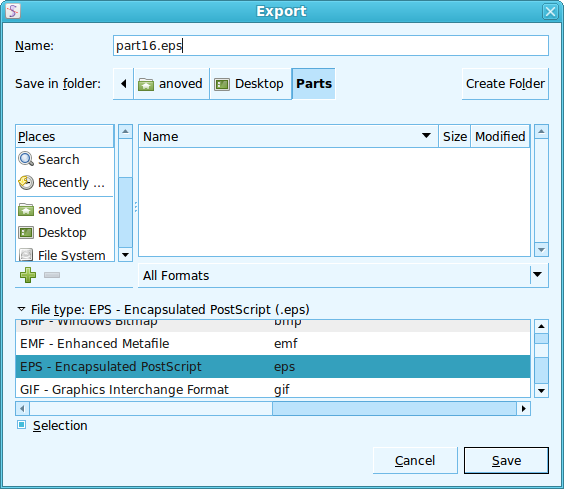
Be sure mm is selected as the unit in the EPS Options window. Click OK.
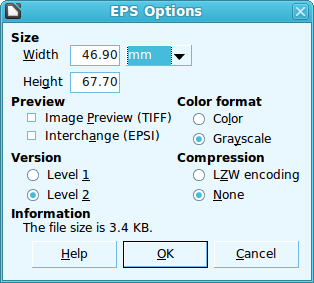
Convert the EPS file to DXF format using pstoedit:
pstoedit -dt -f dxf:"-polyaslines -mm" part16.eps part16.dxf
(There may be friendlier tools available to convert PDF or EPS files to DXF. DXF is needed because it is the only 2D format understood by OpenSCAD, which is used in the next step to extrude the outline into three dimensions. Printrbot part diagrams are available as DXF drawings, but I think it requires a bit more CAD expertise to extract individual parts from those files.)
Use OpenSCAD to import the DXF drawing and give it depth:
linear_extrude(height=6) import("part16.dxf");
Finally, to get a printable STL file, select Compile and Render from OpenSCAD’s Design menu, then Export as STL… from the same menu. Here’s the result positioned in RepetierHost, ready to print:
Another thing to try would be to use OpenSCAD to union an assembly of multiple parts into a model you could print as a single piece for greater rigidity and ease of maintenance. You might also customize the model to accomodate different components. This article on using fasteners with printed parts is worth a look for useful design tips, too.
Posted on Friday, January 24th, 2014.
A Fan Fix
At some point the other day I peeled the sticker off the center of the cooling fan on my Printrbot extruder. I think in so doing I must have budged the solder where the wires enter the fan: last night I realized the fan wasn’t running, regardless of setting. So, this morning I pulled my multimeter out of cold storage (no, really – it is cold in the garage) and verified current was reaching the fan. I was happy to confirm the fan was at fault, and not some connection on the circuit board.
A quick trip to Unicorn Electronics for an identical replacement, and we’re back in action!
The cooling fan helps ensure plastic emerging from the extruder solidifies quickly. Actually, as a test I printed several items earlier this week with it turned off, and didn’t notice a difference in output – perhaps it is more important when the ambient temperature is higher.
Posted on Thursday, January 23rd, 2014.
Building OpenSCAD from Source
OpenSCAD is a useful tool for 3D modeling. You create models in OpenSCAD by writing scripts composed of commands like cube or rotate to instantiate and manipulate shapes. Furthermore, you can combine shapes using constructive solid geometry operations like union or difference. So it is not a substitute for interactive modeling, but a tool for writing programs to generate models from input. For example, Thingiverse Customizer uses OpenSCAD.
I use OpenSCAD with Linux Mint, where it is readily available via the Software Manager. However, the version available there is not the latest. Furthermore, the downloadable version of the latest release on the OpenSCAD web site does not run on my laptop, due to an unnecessarily strict glibc version dependency. So, rather than muck around with a bunch of different versions, I decided to just build the latest code available from Github. Happily, the build instructions work. Here’s a step-by-step summary for Linux (assumes you have git installed):
# download the code git clone https://github.com/openscad/openscad.git # enter the downloaded directory cd openscad # download MCAD part library, stored as a separate repository git submodule update --init # download and compile other dependencies (tools and libraries) # - might take a while depending how many are already installed scripts/uni-get-dependencies.sh scripts/uni-build-dependencies.sh # compile Openscad qmake make
Now you can run openscad from that directory, or run sudo make install to install the app for systemwide access.
Posted on Wednesday, January 22nd, 2014.
PrintrBot Assembly Notes
The Printrbot Simple’s assembly instructions are published online as a photo-illustrated guide. Having recently assemble my own Printrbot, I thought I would share a few comments and tips for the benefit of anyone else about to build one.
First, and most generally, it’s worth reading through the instructions before you begin building to get a sense of how everything it will fit together. At the very least, look at the photos for the next step before you proceed with the current step to see how the current step will look when done.
Find the right tool for the job of separating the laser-cut plywood parts (step 2). I did not settle on a safe and consistent cutting method until I tried the chisel-tip blade pictured at right. (Simply snapping the parts apart by hand is possible, but discouraged due to the possibility of splitting or snapping the parts themselves.) This advice may soon be moot since I understand Printrbot plans to transition to all-aluminum construction.
The zip ties securing the Z axis drive rod coupler (step 40) pass very close to wires from the circuit board. I wrapped a piece of tape around the zip tie nubs to prevent them from accidentally yanking wires as the rod rotates. Careful grouping and routing of wires is general good practice to avoid interference with moving parts.
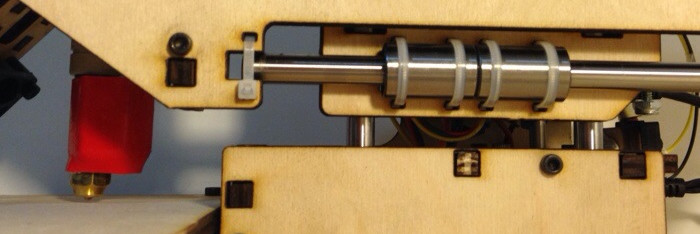
Last but most important: once you’ve finished the assembly, but before you run the printer for the first time, examine the 3″ bolt installed on the back of the extruder carraige in step 30. This is the Z stopper. Its job is to hit the Z end stop switch on the base of the printer (nut and black box at right in the picture above) just before the extruder tip hits the print bed (at left in the picture above). Make sure it is threaded in far enough to do so! Otherwise, the extruder tip will be driven into the print bed when the printer attempts to find its “home” location by descending until the Z stop is triggered.
Posted on Wednesday, January 22nd, 2014.
My Printrbot
Earlier this month I ordered a Printrbot Simple. The kit arrived last Thursday. I stayed up late to assemble it and had a lot of fun in the process – I marvel at the way such a sophisticated class of machine can be built from relatively simple parts. See the photo captions in the slideshow above for comments on particular steps.
Me being me, I can almost claim the kit was worthwhile for the satisfaction of assembly alone. But it works, too! It works very well – better than I expected, to be honest.
I’ve printed a variety of models so far, including some of my own design and some from Thingiverse. Above, my prints of Matthew Croucher’s calibration cubes and Steven Morlock’s version of the bust of Nefertiti. Below, a bicycle taillight adapter I designed and an experiment in painting a landscape model of Binghamton prepared with hmstl.
Physically, I have found two adjustments are key to getting good results.
The first is common to all 3D printers: the bed must be level relative to the extruder; otherwise, the plastic won’t adhere reliably and you’ll get frustrated. Currently, levelling is accomplished by adjusting the spring-loaded screws at each corner of the bed to ensure an even gap between the extruder and the platform across the whole print bed. Thanks to the clever hackers at Printrbot, however, a system that compensates in software for bed orientation is evidently in the works.
Secondly, since the Printrbot Simple’s X/Y motion is driven through lengths of fishing line, it is important to keep these cords taut. My first few prints came out a bit sloppy, largely due to a bit of slack in the lines. I increased the tension and everything since has come out sharp. The cords are now almost tight enough to pluck like a guitar string.
I am using Repetier-Host to control the printer. It provides an interface for placing models on the print bed, converting models to printable instructions using the bundled Slic3r program, and monitoring the status of prints in progress. You can also use it to manually operate the printer’s mechanisms – useful for reloading filament or checking the bed level. The screenshot at right shows a print in progress; you can monitor a graph of the extruder temperature or a visualization of what’s been printed so far (not shown).
Desktop 3D printers build objects by extruding one layer of a model at a time. A slicing program’s job is to convert an arbitrary model into a stack of printable layers, or slices. Thus, the options set in Slic3r (or similar software) have a big impact on the outcome of the print.
Important slicing options include layer height and infill – the density of the filler material, if any, to be laid down within the outline of each layer. Other key settings include the number of perimeter outlines to output for each layer and whether to generate supports for overhanging features – scaffolding to be removed when the print is done, as seen around the Nefertiti bust above. Last but not least, you can configure the speed at which the printer executes each type of task. I find that reducing speed helps reduce unwanted vibrations. At right, a screenshot of the slicing preview of this sweet pencil holder. You can see the internal grid that forms the 0.05 infill consumes little material but provides plenty of reinforcement.
I think a comparison to traditional photography is apt: a great part of the art lies in familiarity with the technology and process, which informs the photographer’s choice of lens, film, and exposure.
Choosing the most appropriate settings for each print is a balancing act between a number of factors: strength, material consumption, print speed, and fidelity to detail, to name a few. I think a comparison to traditional photography is apt: a great part of the art lies in familiarity with the technology and process, which informs the photographer’s choice of lens, film, and exposure.
In conclusion, I gladly recommend the Printrbot Simple to anyone interested in getting into 3D printing – not despite its simplicity, but because of it. It is easy to observe how it works, and thanks to its simple construction, not too intimidating to assemble or adjust. I’ve read a lot about 3D printing in the past few months, but I’ve learned a lot more in the past few days just from playing around with this printer.
Posted on Wednesday, January 22nd, 2014.
Pre Printer
“And the tools were laid out by the build guide with care, in anticipation of the PrintrBot that soon would be there.”
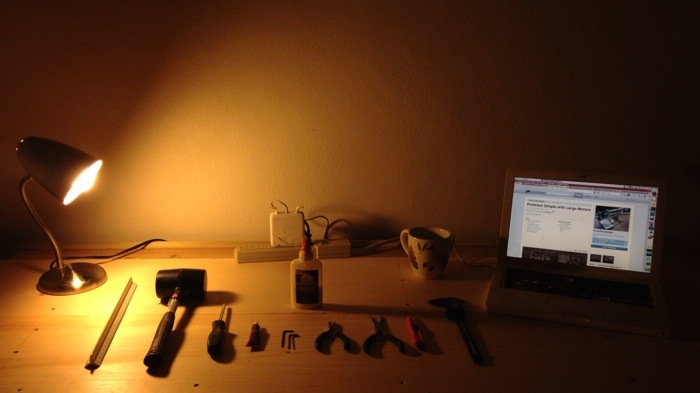
I ordered a PrintrBot Simple kit (with XL upgrade), due to arrive today!
Posted on Thursday, January 16th, 2014.
